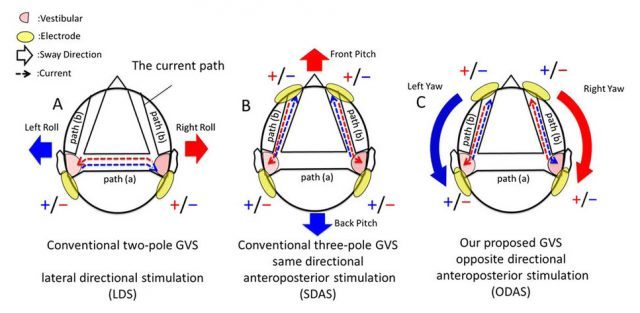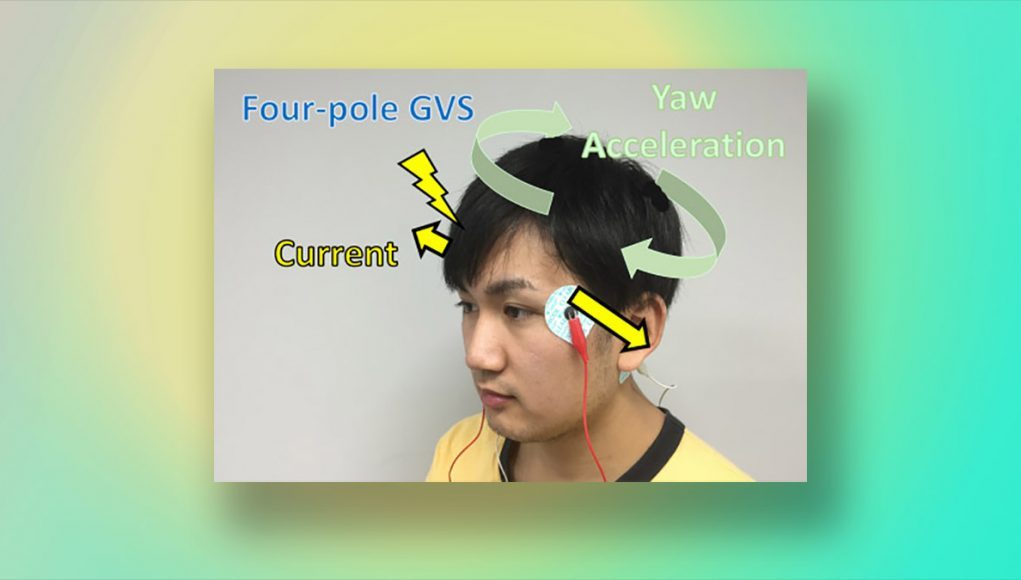Shown as part of the Emerging Technologies installations at SIGGRAPH 2017 this week, the GVS RIDE experience demonstrates the effects of four-pole galvanic vestibular stimulation combined with a VR headset. The technology is pitched as a potential alternative to a motion platform, with its ability to “induce tri-directional acceleration” and “enhance virtual acceleration”.
GVS RIDE is the result of years of studies into galvanic vestibular stimulation (GVS) from researchers at Osaka University in Japan. The demonstration, as described on the Emerging Technologies page of the SIGGRAPH 2017 website, is presented in two parts: firstly, the user has a typical VR experience by watching a conventional VR video without GVS, followed by watching it again with the GVS circuit enabled, which is said to induce a “higher sensation of presence”.
GVS technology has cropped up regularly in VR discussions over the years, and is generally approached with a healthy dose of trepidation and skepticism. Passing electric current through the head is, in itself, a rather alarming concept, which is then compounded by its ability to manipulate our precious bodily sensors. When controlled precisely however, it has the potential to enhance motion sensations, and assist in resolving certain nausea-inducing VR effects. The basic concept is surprisingly simple – electrodes placed behind the ear (on the ‘mastoids’) pass current through the vestibular system (parts of the inner ear), affecting balance. By controlling the current paths, it is possible to induce different balance and acceleration sensations.

A two-pole GVS setup, with an electrode behind each ear, is able to induce lateral movement or ‘roll’, and a three-pole GVS, which fits an additional electrode to the forehead, can induce anteroposterior movement or ‘pitch’. The four-pole GVS system developed by the Osaka University team lead by Dr. Kazuma Aoyama, places two electrodes on the mastoids, and another two on the temples. This is able to induce directional virtual head motion around three perpendicular axes. In other words, they’ve managed to evoke roll, pitch, and yaw sensations.
Dr. Aoyama’s work detailing four-pole GVS was detailed in a report published in the peer-reviewed journal Nature in 2014. I asked him what had changed since that initial publication, and he explained that they now have six-pole GVS, which can induce four directions: “lateral, front-back, yaw-rotation, and up-down”. This advanced system uses six electrodes (two extra on the neck, “5 or 6cm below the mastoids”), used to enhance the vertical acceleration sensation, but for GVS RIDE as shown at SIGGRAPH 2017 they are just using the four-pole system to manipulate three directions.
Dr. Aoyama avoids describing the ‘lateral’ and ‘front-back’ directions as ‘roll’ and ‘pitch’, as it is difficult for a human to differentiate between an actual roll rotational head motion and a linear lateral movement through vestibular stimulation alone. However, this is apparently advantageous, as the interpretation of both movements can be “easily controlled by visual flow”. As such, Dr. Aoyama believes that GVS can suitably align with both rotational and positional tracking in VR.
It’s unclear when or how GVS might be incorporated into a consumer device (although there have been promising GVS experiments with headphones), but the Osaka team believes their lightweight solution can be “easily adapted to conventional VR systems.” The biggest concern is surely the consumer acceptance of such ‘intrusive’ technology and the variability in its effectiveness across a wide range of people. (For example, there are many reports of GVS tests causing discomfort as a result of variable skin sensitivity.)







